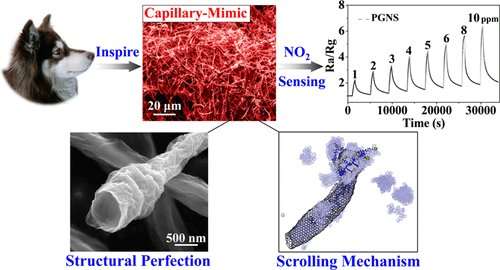Super sniffer: Dog's nose inspires new gas sensor materials

It is well known that dogs have a better sense of smell than humans. For years, researchers have been trying to develop an artificial detector that is just as good as a canine's nose. Now, one group reports in ACS Nano that they were able to mimic a dog's sniffer with graphene-based nanoscrolls.
The inside of a dog's nose is lined with millions of tiny capillaries, which creates a super-sensitive sense of smell. Since the capillaries cover such a large surface area, they can detect odors at extremely low concentrations. Drawing inspiration from the capillary structure in the dog nose, scientists have been trying to mimic it to create a sensitive gas detector. Previous studies have had some success in using graphene-based nanoscrolls (GNS), which are nanosheets of graphene rolled up in continuous and uniform manner. These nanoscrolls have a large surface area, are stable at high temperatures, and are strong and durable. But they are also difficult to manufacture, consume a lot of energy and difficult to scale up. And past studies have used raw graphene or modified graphene that either left behind some unrolled structures, or shriveled up and aggregated, respectively. So Yao Wang, Lei Jiang, Guofu Zhou and colleagues wanted to modify the graphene with a polymer to make high-quality nanoscrolls.
The group prepared graphene-based nanoscrolls with the addition of poly(sodium-p-stryrenesulfonate) using the freeze-drying method to create uniform, unaggregated structures. Upon examination, the nanoscrolls had a wide, tubular shape, and almost all of the graphene was rolled up. The researchers then incorporated the nanoscrolls into a gas sensor, which was highly selective and sensitive. Lastly, the team notes that this method has the potential for large-scale production.
More information: Zhuo Chen et al. Mimicking a Dog's Nose: Scrolling Graphene Nanosheets, ACS Nano (2018). DOI: 10.1021/acsnano.7b08294
Abstract
Inspired by the densely covered capillary structure inside a dog's nose, we report an artificial nanostructure, i.e., poly(sodium p-styrenesulfonate)-functionalized reduced graphene oxide nanoscrolls (PGNS), with high structural perfection and efficient gas sensing applications. A facile supramolecular assembly is introduced to functionalize graphene with the functional polymer, combined with the lyophilization technique to massively transform the planar graphene-based nanosheets to nanoscrolls. Detailed characterizations reveal that the bioinspired nanoscrolls exhibit a wide-open tubular morphology with uniform dimensions that is structurally distinct from the previously reported ones. The detailed morphologies of the graphene-based nanosheets in each scrolling stage during lyophilization are monitored by cryo-SEM. This unravels an asymmetric polymer-induced graphene scrolling mechanism including the corresponding scrolling process, which is directly presented by molecular dynamics simulations. The fabricated PGNS sensors exhibit superior gas sensing performance with reliable repeatability, excellent linear sensibility, and, especially, an ultrahigh response (Ra/Rg = 5.39, 10 ppm) toward NO2. The supramolecular assembly combined with the lyophilization technique to fabricate PGNS provides a strategy to design biomimetic materials for gas sensors and chemical trace detectors.
Journal information: ACS Nano
Provided by American Chemical Society





















